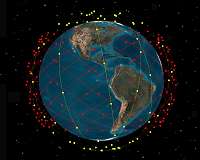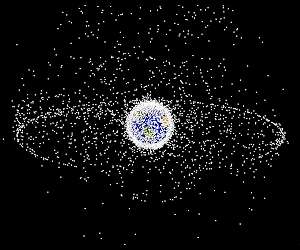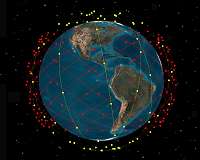
Satellite Industry Association releases space traffic management recommendations and white paper (Image Credit: SNN)
The Satellite Industry Association (SIA) has announced the release of a number of recommendations addressing the issue of space traffic management, with the goal of supporting a long-term sustainable and safe space environment for commercial satellites and spacecraft. The recommendations were included in a SIA White Paper titled “The Future of Space and Space Traffic Coordination and Management (STCM)”.
The White Paper shares SIA and its members’ views and recommendations regarding the creation of a modern STCM regime, capable of supporting long term space sustainability and continued innovation and U.S. space leadership.
“Thanks to technological leaps in innovation and increased accessibility to space, the commercial satellite industry is currently undergoing tremendous growth which is anticipated to increasingly expand in the coming decade.” said Tom Stroup, president of SIA.
The Association and its members are extremely focused on the critical importance of addressing the issue of space traffic management and sustainability now – while developing and maintaining a safe and long-term sustainable on-orbit environment for both domestic and international commercial satellites and spacecraft.”
In the White Paper, SIA projects the profile of active satellites operating in low earth orbit will change substantially in the upcoming 5-10 years with tens of thousands of satellites being proposed.
Regardless of how many of the proposed large constellations are eventually flown, it is clear that that the current framework of space regulations and policies requires review and, in some cases, revision to prepare for the imminent surge in space usage. With this in mind, the SIA White Paper shares the following four recommendations:
Action and funding is needed now. The commercial satellite sector is innovating quickly and driving U.S. leadership in space. SIA urges the U.S. government to act now and to implement a more modern STCM environment to support this innovation, including leveraging both commercial and government capabilities to yield a U.S.-developed cutting edge space sustainability model. This activity requires adequate funding to enable all the related activities foreseen in Space Directive 3.
The Framework should be established, but the specific technologies to meet requirements should not be dictated. Space companies are world-renowned for their ingenuity. Allowing innovative ways to meet the specified requirements of a modern space safety framework will encourage development and ensure the most cost-efficient and effective technologies are utilized.
Governments should encourage best practices. The commercial space industry has a long track record of responsible operations in space and counts on a safe environment to undertake ongoing and future space business.
Solidifying the participation and support of the commercial industry to ensure wide-spread adoption of space safety practices is critical and will reduce the need for unnecessary and often burdensome regulations and is action that can be taken now.
Any effective solution must be whole of space and endeavor to meet global needs. A successful, modern and sustainable space traffic management system will include all of the types of space activities (listed in this White Paper), U.S.
and international alike. This will require the relationships and leadership of the U.S. government, commercial stakeholders and like-minded space-faring counterparts to meet the important goals of space sustainability.
To view a copy of the SIA White Paper “The Future of Space and Space Traffic Coordination and Management”, please click here.
Related Links
Satellite Industry Association
Space Technology News – Applications and Research
|
Thanks for being there; We need your help. The SpaceDaily news network continues to grow but revenues have never been harder to maintain.With the rise of Ad Blockers, and Facebook – our traditional revenue sources via quality network advertising continues to decline. And unlike so many other news sites, we don’t have a paywall – with those annoying usernames and passwords.Our news coverage takes time and effort to publish 365 days a year.If you find our news sites informative and useful then please consider becoming a regular supporter or for now make a one off contribution. |
||
|
SpaceDaily Monthly Supporter $5+ Billed Monthly |
||
paypal only![]()
![]()
SpaceDaily Contributor
$5 Billed Once![]()
credit card or paypal

![]()
18 SPCS now predicts debris-on-debris collisions in space, enhancing Space Domain Awareness for all
Vandenberg AFB CA (AFNS) Sep 29, 2020
For the first time, the Combined Force Space Component Command’s 18th Space Control Squadron began publically sharing data for debris-on-debris conjunction predictions via http://www.Space-Track.org, Sept. 24.
Previously, the 18 SPCS only released debris-on-active satellite conjunction prediction data publically due to limited conjunction screening and reporting capacity.
Through a project titled Reduction of Conjunction Assessment Processing (ReCAP), 18 SPCS personnel reduced the daily number of l … read more
– Advertisement –









